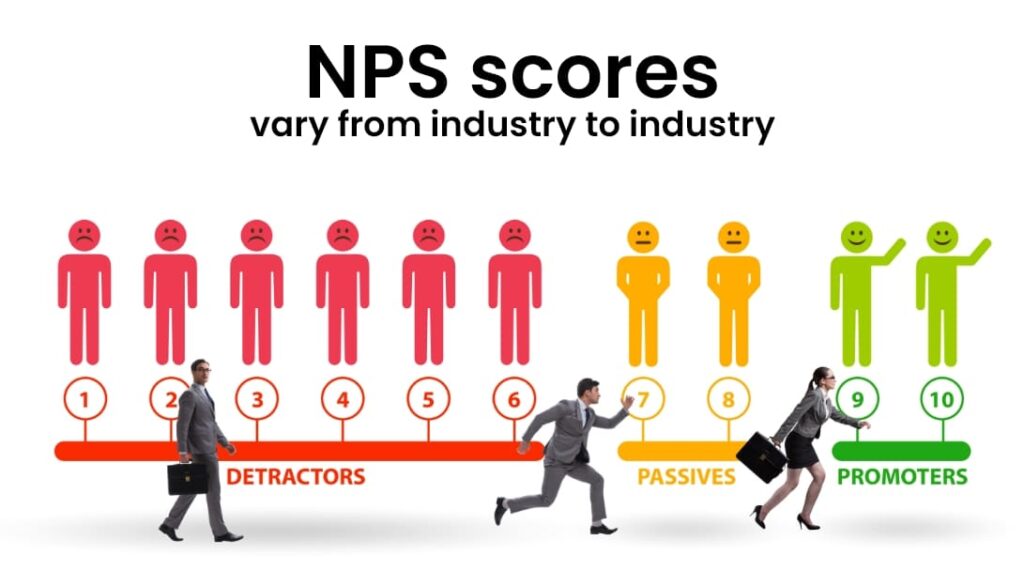
Want to ensure a good Net Promoter Score for your business?
Start by understanding the importance of personal recommendations in the decision-making process.
Just as we turn to our friends and family for guidance when making life-changing decisions, customers rely on recommendations from others to decide whether to opt-in or opt-out of a brand.
These recommendations speak volumes about how loyal and satisfied customers are with your brand.
While most businesses resort to Net Promoter Score to constantly check customer loyalty and gauge customer satisfaction, few are still figuring out answers to the pertinent question – ‘What is a good Net Promoter Score.’
If you are sailing in the same boat, we are here to help!
This blog spills the secret behind a good Net Promoter Score and how to achieve it. But before that, let’s get our basics of NPS right.
What Is NPS?
Net Promoter Score, or NPS as it is popularly known, is a powerful metric to measure customer loyalty and satisfaction.
The score is determined by a single question – “How likely are you to recommend our company to your friends and colleagues?” with 0 to 10 as the answer options.
It also provides a ‘why’ section where customers can elaborate on the score and give detailed feedback.
You can watch this quick video to understand Net Promoter Score better.
Watch: What Is Net Promoter Score (NPS) and Why Businesses Use It?
Based on the ratings customers provide, customers are classified into three groups:
- Detractors – These are customers scoring you between 0 to 6. They are usually unhappy with your services and least likely to recommend you to anyone in their social network. In fact, they can spread negative reviews and tarnish your company’s image
- Passives – Customers who rate you as 7 and 8 are passives. They are people who are indifferent towards your brand – neither happy nor unhappy, but they won’t mind switching to a competitor.
- Promoters – Well, these are the enthusiastic, selfless brand promoters that every brand strives to earn. By rating 9 and 10, these customers prove their unshakeable loyalty to a brand. They are highly satisfied and would love to share their positive experiences with people in their social circle.
NPS is a stellar customer feedback tool to spot your top customers, those who are indifferent, as well as those who are on the verge of leaving. While you cannot immediately change the mindset of the stubborn detractors, your aim with NPS should be to constantly improve your customer experience and earn more and more promoters.
The comment section of NPS is a great place to discover what makes customers love and hate your brand. You can use the detailed feedback to build loyalty programs to retain promoters and take corrective measures to win back your detractors. You can even compare your NPS score with others in the industry to understand where you stand amongst your competitors.
Now comes the million-dollar question that businesses are still struggling with – ‘What is a good NPS?’
Well, we might have the answer for you in the next section.
What Is a Good Net Promoter Score?
Since NPS was invented, one question plaguing businesses is – “What is a good Net Promoter Score?”
It looks like not many are good in this number game. So, here we are to help you crack the code to a good NPS score.
First things first. A good NPS score indicates a high number of promoters who selflessly promote your brand and spread positive word of mouth. This magic number tells a lot about how successful your strategies are in keeping customers and gaining their love and loyalty.
Before we answer the question ‘What is a good Net Promoter Score’, it’s crucial for you to understand something fundamental. A perfect NPS score doesn’t exist.
Think for a second, is it really possible for you to have only promoters and no detractors at all?
While such perfect situations are possible in a parallel universe, in reality, it’s just a dream that never comes true. A healthy approach would be being practical and aiming for positive NPS numbers in your industry.
So, what NPS score is considered healthy or excellent?
Here are some ways to understand whether you have a positive or negative NPS score.
1. General Benchmarking
The range of the NPS can be as low as -100 (every customer is a detractor) and as high as 100 (every customer is a promoter). However, NPS never reaches these two extremes.
- High Range: More promoters are taking the business towards growth.
- Low Range: More detractors are ruining the company’s image.
According to the creators of NPS, here is the breakdown of the scores:
- Below 0 – Customers aren’t happy. There is considerable scope for improvement for companies falling in this range.
- 1 to 30 – This score is acceptable, but there is still a lot that companies can do to grow.
- 31 to 50 – Most companies get NPS scores in this bracket. It shows they value customer experience as a good number of customers are willing to recommend the brand to others.
- 50 to 70 – Companies with scores in this range have a large group of promoters.
- 70 to 100 – Such scores are difficult to attain. Businesses with scores in this bracket are leading the market.
This means if your score is below 0, it’s time to pull up your socks. A score above 50 is great and shows you value customer satisfaction more than anything else. An NPS rating of 70+ indicates your unwavering commitment towards customers and their immense love for all you do for them.
This general benchmarking can be termed Absolute NPS, which compares your score with companies across industries.
2. Comparison with Competitors
Analyzing how your NPS rating stacks up against your competitors tells a lot about your market position. This analysis helps you measure your real growth in terms of your competitors.
For example, it’s good if you are in the airline industry with an NPS score of 35. But if your competitor achieves a score of 55, you know you can’t rest on your laurels and still have a long way to go.
Besides, NPS scores vary from industry to industry. For example, airlines tend to get higher scores than banks, or department stores are likely to receive a higher NPS than insurance companies.

The ideal approach is to compare your NPS score with competitors in your industry. It gives a realistic picture of where you stand in terms of customer loyalty as compared to your counterparts in the same field.
3. Compare Your Current NPS Score with Previous Scores
There is no particular answer to – ”What is a good NPS score?”. It’s all relative and depends on a lot of factors, such as your own previous performance.
As an individual number, NPS doesn’t reveal anything. Only when you use it in context, such as comparing yourself with your competitors or your past scores, can you measure the progress you have made so far.
While deciding a good Net Promoter Score for yourself, remember that you are your best benchmark. A consistent improvement in scores in a month, quarter, or half-year shows that you are heading in the right direction.
For example, if your NPS was 20 in the previous quarter and it jumped to 35 in the current quarter – you are clearly running on the right track!
Our Take on What Is a Good Net Promoter Score
What exactly is a good NPS score, and which method should you adopt to calculate it?
Truth be told, we believe it’s always a better idea to compare yourself with your previous performance. You are your own best benchmark and your competitor. Your competitors may be consistently generating great NPS scores, and your scores might look like peanuts in front of theirs.
Is that something you should be disappointed with?
Yes and No.
Yes, because it’s natural to feel bad when competitors get customers’ love and attention. Instead of brooding, consider their scores as a benchmark and strive to deliver high-quality customer experiences that match the standard they have set.
No, because if your current NPS score is better than your previous score, it means you are one level up from what you were before. Isn’t that great? For long-term success, what really matters is consistent improvement over your own performance. Beat your scores every quarter or every six months, and watch yourself outgrow your competitors in a couple of years. That’s how powerful self-improvement can be!
Take note of how you are progressing and your NPS trend. This analysis is crucial to make practical decisions for improving brand perception and customer loyalty.
FREE. All Features. FOREVER!
Try our Forever FREE account with all premium features!
How NPS Impacts Customer Loyalty
NPS has a significant impact on customer loyalty. An NPS survey asks your customers how likely they are to recommend your company’s product or service to others.
If you have a higher NPS score, it means you have a good amount of customers as Promoters. And these Promoters are loyal customers who not only continue to do business with you but also actively promote your business’ products and services to others. They serve as brand ambassadors and can influence the buying decisions of their friends and family members. This then leads to increased customer loyalty of their friends and family too.
On the other hand, a low NPS score indicates that customers are unhappy and are more likely to switch to a competitor. Therefore, you must monitor and improve your NPS score to increase customer loyalty and retention.
That said, let’s take a look at the importance of having a good Net Promoter Score.
Importance of Good Net Promoter Score
A good NPS is important for any business. Here are a few reasons why:
1. Positive Word of Mouth
Word of mouth is one of the most powerful marketing tools, as people trust recommendations from friends and family.
A good NPS means customers are likelier to recommend your business to others. This enables positive word of mouth, which helps attract new customers.
2. Customer Retention
Customers who are satisfied with your business can stay loyal and continue doing business with you.
A good Net Promoter Score implies that you are doing something right and meeting your customers’ needs and expectations. And this leads to increased customer retention and repeat business.
3. Insights for Improvement
Your New Promoter Score provides valuable insights into what is working well and which areas need improvement in your business.
By analyzing the feedback from promoters, passives, and detractors, you can identify areas for improvement and make changes to better meet your customers’ needs.
4. Competitive Advantage
A good NPS score can give you a competitive advantage over other businesses in your industry.
How?
Customers are more likely to engage in business with companies with a good reputation for customer service and satisfaction. And a high NPS sets you apart from your competitors!
Factors Affecting Your NPS Scores
It’s not easy to earn customer loyalty. There are mountains to climb and oceans to cross to achieve the loyalty you want from your customers.
While surveying customers, receiving the scores, and analyzing them are pretty straightforward, multiple factors can influence customer loyalty toward your brand.
Let’s look at the key factors that impact your NPS scores.
1. Competition in a Niche Industry
Niche industries usually have a few businesses dominating the entire market. Due to the lack of players, there is less competition, which gives customers few options to choose from. With little to no choice, customers tend to be satisfied with the experiences they receive from the single best player in the industry.
Only a few bigwigs lead this segment thanks to the minor competition existing in the market.
Take, for instance, Tesla. This leading electric car manufacturer tends to get a high NPS score, but does that mean the quality of their cars and customer service are exceptional? Not really!
You can’t deny that Tesla makes amazing cars, but there are also various downsides. The reason behind the excellent score is that customers do not have any good competitors to compare Tesla.
Two things to note here – a unique value proposition and a less crowded market. A high NPS score is guaranteed if you are a company operating in a niche segment with minor competition and offering an attractive value proposition.
2. Customer Tolerance Towards Your Industry
Customer tolerance is a key factor determining the NPS benchmarks for a particular industry. How tolerant customers are towards the experiences they receive varies from industry to industry. Their tolerance level shows how much or how little customers depend on your brand.
To check the tolerance level of customers, ask, “How likely are you to be disappointed if we can’t address your needs immediately?” Provide a score range of 0 to 10, with 0 being the least likely and ten being the most likely.
If the score is near 10, you are operating in a low-tolerance field. And a score of around 4 shows that yours is a high-tolerance industry.
Some industries, such as healthcare, have a low tolerance level, while others, like online streaming services or car rentals, show good tolerance. That’s something pretty obvious!
The inability to immediately meet the needs of patients is more likely to bring the NPS down drastically than a car rental service throwing challenges of booking and pricing occasionally.
3. Timing of Global Events
Global events taking place every once in a while have the power to shake customer attitudes and behavior and bring many businesses down to ashes.
The timing of such events is a key factor in determining NPS score benchmarks. Whether it is an event at the global or local level, it can directly influence customer interests and impact your NPS score.
For example, the Covid-19 pandemic hit businesses hard. Many are still struggling to stay afloat. This is primarily the case with a few industries, such as airlines, hospitality, rental cars, etc. Travel restrictions and a series of lockdowns affected these businesses deeply, bringing down the quality they once used to boast of.
Unsurprisingly, such events, though rare, can significantly bring down the NPS scores of the worst-hit businesses.
4. Quality of Customer Support
Customers are more likely to shower companies with high scores if they receive top-class treatment from your support staff every time they need help.
A company’s actual value is determined by its commitment to customers even after purchasing. Customers will have problems and reach out to you – that’s their job. Your job is to treat customers with the same respect and give them the same attention you did when you were eager to onboard them.
A positive support experience across customers’ preferred channels – social media, phone, live chat, ticketing, or even self-service, goes a long way in earning lasting loyalty.
Strive for quality in every customer support interaction, and you will be one step closer to earning a good NPS score.
The above-mentioned factors can significantly influence your NPS scores, so do keep a watch on them while analyzing your NPS scores.
How to Improve Your Net Promoter Score
Whether you receive a low, average, or high NPS score, there is always room for improvement. NPS is like a health check showing where you currently stand and what you should do to advance.
Here we will discuss some practical ways to raise your score from what it currently is to what it should ideally be.
1. Analyze the NPS Scores to Spot Trends
The purpose of NPS is to identify your brand loyalists and detractors. With scores pouring in from all directions, analyzing them can get extremely challenging. And if you fail to evaluate the results, confusion regarding the following steps will likely prevail.
Before you improve your NPS scores, it’s important to measure and analyze them. Modern survey tools like ProProfs Survey Maker come with built-in AI-powered reports that can be generated daily, weekly, or even monthly. The reports gather all the NPS data and present it to you through visually appealing graphs and charts to make analysis easier.
This means you don’t have to waste time manually sorting your promoters, detractors, and passives. Reports can do that for you and even more. They provide additional information about who took your survey, when it was taken, and how the participants responded.
With the right data up your sleeves, you can easily compare NPS data with previous scores, identify your most prominent loyalists and detractors, and make informed decisions.
2. Handle Your Detractors with Care
Remember this quote by Bill Gates – “Your most unhappy customers are your greatest source of learning.”?
This quote was relevant ten years ago, and it also stands true today.
Detractors are the people who are least satisfied with your company, which means there is something you aren’t doing right. Their frustration level is at its peak, so you need to show extra care while handling their feedback.
Leave no stone unturned in addressing the feedback given by detractors. Ask your support team to address their requests, respond promptly, and show them your best side. Once you address their concerns, send surveys to gauge their satisfaction with the responses and if there is something else you can do to meet their needs.
Detractors can open your eyes and expose you to problems you never knew before. Look out for common problems that most detractors face and prioritize your energies towards fixing them. This is a surefire way to win back most of your detractors.
Here’s a video that tells you more about how to improve your NPS scores.
Watch: How to Improve Net Promoter Score
3. Work on Your Customer Support
If you have the best products and services, a poor or average NPS score can be blamed for inadequate customer support.
The quality of your support can make or break the customer experience and massively impact your loyalty scores.
The good news is that customer support, and in turn, the experience customers receive, can be improved by doing just a few simple things right.
For example, don’t make customers wait when they are frustrated and looking for a quick fix. Be active on all the channels they frequently use, be it social media, chat, emails, or phones. Take help closer to your customers and prevent them from contacting you by equipping them with a powerful self-service help center.
Be empathetic to their problems, communicate better, and, most importantly, show them that you care and have the perfect recipe for a good NPS score.
4. Invest in Your Products & Services
Whether you are a year-old startup or a big multinational company, one thing is clear – customers value good products and services.
They can ditch a big brand if they find more value in a startup’s products and vice versa. So, your NPS score boils down to the experience customers receive when using your products and services.
Recurring positive experiences build trust in customers so that even if given a choice, they would stick to your brand. No one wants to switch to a competitor and begin the relationship from scratch unless and until a bad experience forces them to do so.
Look at what your competitors offer, identify what customers need, and work towards improving your products and services. Your product should continuously evolve as customer needs change to meet those needs.
A great product = Happy customers = A good NPS score
5. Find Ways to Delight Promoters & Improve the Experience of Passives
Focusing on promoters and passives is just as important as caring for detractors. There are multiple reasons promoters love your brand and are ready to selflessly promote it in their social network.
With NPS, you can find those reasons and continue to deliver better value to promoters so that even the thought of abandoning your brand doesn’t cross their mind. And even if it does, the love you’d reciprocate to customers will keep them coming back to you.
Regarding passives, consider trying to find what they are unhappy with. Because unless you don’t know the reasons, you will be incapable of improving their experience.
That’s why the ‘why’ section of the NPS survey is so important, besides the numerical score. It gives a deeper insight into why a customer chose a particular score for you. You can use it to identify areas where you fall flat and put in the required efforts to enhance the experience of passives and turn them into your biggest advocates over time.
FREE. All Features. FOREVER!
Try our Forever FREE account with all premium features!
Format of the NPS Survey
The Net Promoter Score (NPS) survey consists of a single question that asks customers to rate their likelihood of recommending a company on a scale of 0-10. The question is typically followed by an open-ended question asking customers to explain their rating.
The NPS survey can be shared through various channels via email, social media, pop-ups, in-app surveys, or as a link.
The most common method is email, where customers are sent a link to the survey. The survey can be customized with the company’s branding and personalized with the customer’s name.
The survey can be conducted regularly, such as quarterly or annually, to track changes in customer loyalty and satisfaction over time. The survey results can be used to identify areas for improvement and to prioritize initiatives to enhance the customer experience.
How to Take Action Using NPS Results
Net Promoter Score (NPS) results can provide valuable insights into customer loyalty and satisfaction. However, taking action on the results is important to improve the customer experience and drive business success.
Here are a few steps to take action using NPS results:
- Analyze the Feedback: Start by analyzing the feedback from promoters, passives, and detractors. Look for common themes and areas for improvement.
- Prioritize Initiatives: Based on the analysis, prioritize initiatives to improve the customer experience. Focus on initiatives that will most impact customer satisfaction and loyalty.
- Develop an Action Plan: Develop an action plan with specific goals, timelines, and responsibilities. Assign ownership of each initiative to a team member or department.
- Implement & Measure Progress: Implement the initiatives and track progress towards the goals. Regularly measure NPS results to see the impact of the initiatives on customer loyalty and satisfaction.
- Continuously Improve: Continue to analyze feedback and adjust the action plan as needed. Use the NPS results as a benchmark to constantly improve the customer experience.
Improve Your NPS Score & Earn Lasting Loyalty
Contrary to popular belief, NPS is not just a number you need to grow. It is a qualitative metric that helps you reflect on your past actions and analyze them to improve your future.
Every business today runs after achieving customer loyalty and increasing its NPS scores. They forget that this magical score is determined by one simple thing – treating your customers right!
In a rush to nail this number game, most businesses often get confused with ‘what is the good Net Promoter Score.’ A score that works for company A might not work for company B due to the factors mentioned above. Knowing what’s good for you and what’s not is crucial to make the right decisions that can help you win the loyalty of your customers.
When it comes to NPS, always have a progressive approach. Compare your current scores with previous performance and analyze how much you’ve progressed and how much you still need to improve.
And if you need help with your NPS, we’re always there for you!
Do you want free survey software?
We have the world’s most versatile survey tools Free plan available. Paid plan starts at $19.99/100 responses/month
 Tips
Tips
We’d love to hear your tips & suggestions on this article!
FREE. All Features. FOREVER!
Try our Forever FREE account with all premium features!


 We'd love your feedback!
We'd love your feedback! Thanks for your feedback!
Thanks for your feedback!







